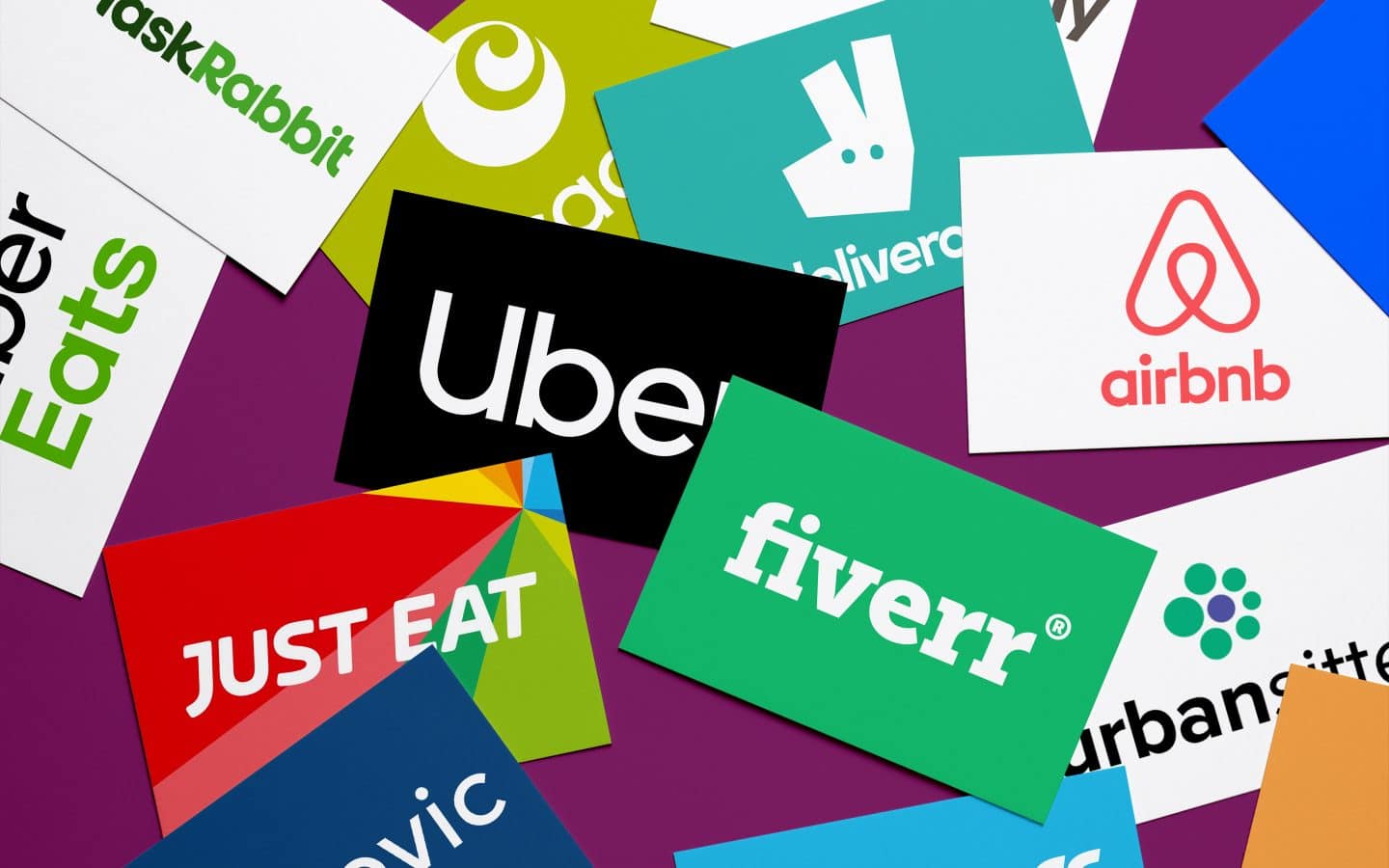Often dismissed as ‘Gig Economy’, the new age economy has made impressive strides especially in the post-Corona world. And the pandemic has irrevocably altered the face of the world, as the Corona outbreak has taken a heavy toll on the world economy, Gig economy has come as a blessing in disguise for the world.

(Image source: New Straits Times)
“I have called myself an Uber, I’ll pick you up on the way.”
“Sara and her friends have rented an Airbnb for their trip to Pondicherry.”
“I hired a graphic designer off Fiverr to design my company’s logo.”
These expressions sound familiar, right? They have become part of the common lingo in Gig Economies, a concept that has amassed popularity in the 21st century.
What is a Gig Economy?
A ‘gig’ is a relatively new addition to the Thesaurus, meaning a temporary work agreement, usually via online platforms. Under this economic system, short term contracts and one-time paid work are preferred over regular salaried employment. Uber, Lyft, Amazon, Grub Hub, Swiggy, Zomato, UpWork, Postmates and Door Dash are some popular gig employers that you may know about and frequently use.
These companies hire skilled and semi-skilled people temporarily, also called freelancers. They are self-employed individuals who are not necessarily committed to a single organisation and get paid for an isolated piece of works. As a freelancer, you are your own boss.
This work arrangement liberates working professionals from the hamster ball of 9 to 5 jobs and gives them the flexibility to work from the place of their choice, at the time they deem fit, on their own terms.
Why Gig Economy?
The ongoing health crisis has dented economies around the globe and put countless businesses on life support. These companies and small businesses are desperately looking for ways to cut down costs and increase their output to strengthen their footing. A lopsided workload calls for highly skilled and adaptive staff members. Nevertheless, this would also mean shelling out money to upskill permanent employees. Only 18% of CEOs worldwide have noted significant enhancement in the efficiency of upskilling their organisations
Women are the primary benefactors of the flexibility provided by the freelancing job model. A study by Harvard University reveals that women in gig economies have outgrown men. Every one out of five freelancers in India is a woman. Freelancing allows career-driven women to resume their careers and promises them with financial independence. A Sangeeta living in the remote area of Mumbai doesn’t have to compromise on her family to pursue her career.
Thanks to digitisation and globalisation, giggers are also called Virtual Migrants. Their motto is “Earn in Dollars, Spend in Rupees!” A certain Priya can now interact with her clients in Silicon Valley, develop a customised website for their company and get paid via PayPal, without moving an inch from her home in New Delhi. This is no less than a workplace revolution!
The perks of freelancing are not just limited to an international clientele, but also access to a gigantic community. The gig economy presents its workers with a unique opportunity to cultivate a forward-facing network and grow professionally. Websites like LinkedIn, Fiverr, Freelancer and Task Rabbit help build a professional community for freelancers, self-employed individuals and all other working professionals. It presents job openings for anyone from a data scientist to packers and shippers.
Who says you cannot pursue multiple talents as careers? As a gigger, you can choose from an array of job options and explore different avenues upon your whim. Shattering traditional workplace norms, this setup opens up to a flood of opportunities and lets you diversify your career without being tied down to a single profession. An archaeologist can take up web designing projects while a nurse can supplement her income by working as a content writer. In a gig economy, the sky is the limit!
All things being equal, one can expect gig economies to boom in the post-COVID era. With approximately 20 million’ giggers’ thriving in our economy, one out of every four freelancers in the world is an Indian today.
The rise of freelance work has given birth to countless ancillary services and ushered us towards many trends in the business environment. One of them is Coworking- a billion-dollar industry that allows workers from different companies to work and share the same office space. It brings down the cost of operation for these organisations through the use of common infrastructure.
There are approximately over 35,000 coworking spaces over the globe with a market value of roughly 26 billion dollars. This is why gig economy is also known as a ‘collaborative’ or ‘shared-economy’.
What is the future of Gig Economies in the light of the Pandemic?

The ongoing health crisis has dented economies around the globe and put countless businesses on life support. These companies and small businesses are desperately looking for ways to cut down costs and increase their output to strengthen their footing. A lopsided workload calls for highly skilled and adaptive staff members. Nevertheless, this would also mean shelling out money to upskill permanent employees. Only 18% of CEOs worldwide have noted significant enhancement in the efficiency of upskilling their organisations.
This makes hiring freelance workers a more viable option for these businesses. Neither do organisations have to spend on their training and development, nor do they require a financial commitment to hire full-time employees. This way they can access the skills, experience and expertise that their existing employees may lack.
Another reason for this shift can be attributed to the mortality of businesses and short-lived tenures of working professionals in the corporate world. Statistically speaking, the average lifespan of companies on the S&P 500 is expected to decline from 33 years in 1965 to only 12 years by 2027. At the current churn rate, about 50 per cent of S&P 500 companies will be replaced over the next ten years. This sheds light on the turbulence caused by the creative destruction of industries, tremors of which can be felt in India.
According to the Bureau of Labor Statistics, the median tenure of a working professional is 4.2 years, a CEO is 8 years, a CFO is 5.1 years and a CMO is 4.1 years in the United States. This number highlights the easy replaceability of employees in the job market. On observing this work pattern closely, one shall realise that we all are gig workers in a way.
What are the problems with Gig Economy?
Many employers take undue advantage of freelancers by categorising them as independent contractors so that they can evade the perks they have to give to regular salaried employees such as minimum wage, health insurance, labour rights and unions among others. This saves them a lot of money as well as tax benefits by getting away on minor technicalities.
Gig economy workers do not enjoy job security or a steady paycheck because of the irregularity of income. Fierce competition in the globalised market also results in loss of bargain power and makes giggers vulnerable.
Technology, coupled with globalisation, has played an instrumental role in binding the world together and bridging the gap between people. Over the last two decades, a hyper-connected world has changed the way people earn, save and spend their money. Freelance work has become a turning point and is considered to be an emerging force in the Fourth Industrial Revolution.
According to Dr Guy Standing, a professor at the University of London, freelancers often feel that they’re not doing enough. This distant nagging guilt makes them take up ‘one more uber ride’ or ‘one more delivery’ to utilise their time and earn an extra buck optimally. This often results in a poorly regulated work-life balance and hampers the ability of giggers to draw a line and ‘switch off’ from their work mode.
This can potentially lead to a burnout, which is a state of mental, physical and emotional exhaustion due to excessive or prolonged stress. A study by Harvard University demonstrates that “Over-worked die young.” This means that a gigger lifestyle can be harmful for professionals in the long term, which might not be good news considering the rapid adoption of this labour model.
How can we make Gig Economies sustainable?
All things being equal, one can expect gig economies to boom in the post-COVID era. With approximately 20 million’ giggers’ thriving in our economy, one out of every four freelancers in the world is an Indian today. This is why it is important for us to make it a sustainable labour model that benefits all its stakeholders. There is a wide scope of steps that can be taken to improve the condition of gig workers by the concerned authorities.
The concept of a universal basic income can positively impact freelancers and can reduce the uncertainty in their work and safeguard against the irregularity of income. It can be guaranteed by the government or jointly by the state and online freelancing websites through which the freelancers offer their services.
According to Dr Guy Standing, a professor at the University of London, freelancers often feel that they’re not doing enough. This distant nagging guilt makes them take up ‘one more uber ride’ or ‘one more delivery’ to utilise their time and earn an extra buck optimally. This often results in a poorly regulated work-life balance and hampers the ability of giggers to draw a line and ‘switch off’ from their work mode. This can potentially lead to a burnout, which is a state of mental, physical and emotional exhaustion due to excessive or prolonged stress.
Global strategists are considering many potential workforce policies like ‘Portable Benefits’. These are transferable perks that employees can take to each new job they have. The employer would contribute to these benefits on the basis of the quantum of work done for him.
A few workplace norms are already in place to ensure that it becomes difficult for employers to classify workers as independent contractors. ABC Test is a three-part test that employers must meet to classify a worker as an independent contractor. Thus, an employer has to prove that workers are independent contractors and not the other way round.
At last, some people also feel that it’s the moral obligation of consumers to compensate for giggers’ security as we are the primary benefactors of the freelancing scheme. The objective is to ensure minimum security for freelance workers so that they do not feel disposable.
Conclusion
Technology, coupled with globalisation, has played an instrumental role in binding the world together and bridging the gap between people. Over the last two decades, a hyper-connected world has changed the way people earn, save and spend their money. Freelance work has become a turning point and is considered to be an emerging force in the Fourth Industrial Revolution.
According to a report by McKinsey in 2017, 84% of the freelancers are satisfied with their work and have actively chosen this lifestyle for themselves. Although there is a wide scope for development in this model, one can safely assume that freelancing is here to stay. All these phenomena together have catalysed the Gig Revolution worldwide. Therefore, it wouldn’t be outrageous to think the earth, as we know it today, has become flat again.
(The author writes about Business, Economics and Finance. Her personal blog ‘Financially Speaking with Aastha Goswami’ is at aasthagoswami.com)













Comments